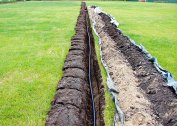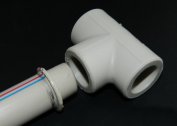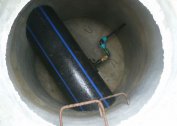A downhole screw or screw pump is designed to solve the problem of water supply in small private and country houses, small agricultural land. The advantage of the device is the ability to work in the presence of solid impurities in water, even at high concentrations. Therefore, for Abyssinian wells and weak wells, screw water pumps are the most optimal option.
Purpose and scope
 Unlike centrifugal water pumps, where the main element is a pumping wheel, the basis of the mechanism of screw equipment is the Pythagorean screw or screw. A similar design is used in a meat grinder. To increase the pressure in the equipment, the housing is equipped with additional segments - steps. There are different configurations of screw pumps, some of them are additionally equipped with an automatic control system.
Unlike centrifugal water pumps, where the main element is a pumping wheel, the basis of the mechanism of screw equipment is the Pythagorean screw or screw. A similar design is used in a meat grinder. To increase the pressure in the equipment, the housing is equipped with additional segments - steps. There are different configurations of screw pumps, some of them are additionally equipped with an automatic control system.
Small-sized water units for domestic use are made of one common shaft. In industry, multi-shaft are most often used. In production, special attention is paid to sealing work surfaces. Graphite and ceramics are used as sealant.
Screw pumps have a wide range of applications in the agricultural industry and other industries:
- transportation of food during packaging;
- pumping oil and its derivatives;
- natural gas production;
- pumping water during coal mining;
- transportation of oily liquids.
Especially widespread use are screw pumps in the domestic field. They are installed in private courtyards for the extraction of water from wells.
Types, principle of operation and device
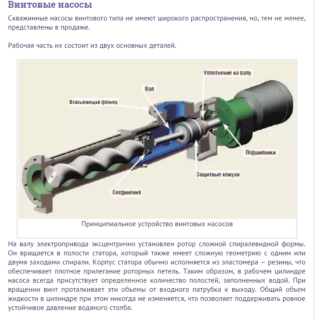 Screw units for pumping water are divided into two large groups: single-screw and multi-screw. For individual use for domestic purposes, single-screw models are installed, they are enough to provide water for an economic land or a private house.
Screw units for pumping water are divided into two large groups: single-screw and multi-screw. For individual use for domestic purposes, single-screw models are installed, they are enough to provide water for an economic land or a private house.
To prevent running water from the water tap with admixtures of sand, silt and algae, a coarse filter is additionally installed at the inlet pipes.
Unlike centrifugal structures, screw are compact in size, but at the same time create high pressure. The diameter of the housing is reduced, because the design is, roughly speaking, one shaft.
The rotor is a rotating screw, the stator is the inner surface of the housing. As a rule, a screw is made of high-quality metal, and the working surface of the stator is made of plastic materials. When the rotor performs revolutions, water is sucked into the inlet pipes and moves in a spiral to the outlet.
Criterias of choice
To acquire suitable equipment, the main selection criteria should be considered. Improperly selected equipment often fails, and also due to technical limitations, is unable to fulfill all the tasks assigned to it.
When buying, it is important to pay attention to such characteristics:
- Power and performance. It depends on this parameter whether the pump will be able to provide the right amount of water supply system. If there was no previous experience, it is better to consult with employees of a utility or water utility.
- Manufacturing firm. It is better to refrain from buying a pump of dubious quality from an unknown manufacturer. Reliable imported pumps are expensive. However, do not underestimate Russian products.The popularity of pumping stations of the Kharkov plant Promelectro, as well as Russian units Aquarius, is growing.
- Well depth. This figure is perhaps the most significant when choosing equipment for water supply. The greater the depth of the liquid, the more powerful the equipment is required. In addition, it is important to consider the distance from the entrance to the distributor to the water intake. 10 m of the horizontal section equates to 1 m of rise from the depths.
- The cost varies widely and depends on the features of the configuration of the model. Saving when carrying out water supply and sewerage is not recommended, since cheap pumps of dubious quality quickly fail, and their repair will inevitably require additional costs.
Before buying equipment, you need to carefully read the attached documentation and warranty card. All technical parameters of the model are described in detail in the instruction manual.
Installation and connection, operation features
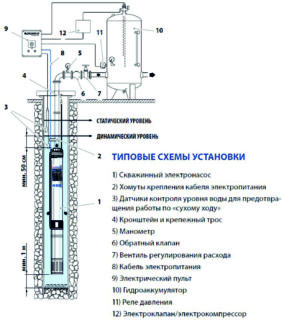 When the drilling work is completed and the inside of the well is equipped, you need to proceed with the installation of pumping equipment. Installation of screw pumps is as follows:
When the drilling work is completed and the inside of the well is equipped, you need to proceed with the installation of pumping equipment. Installation of screw pumps is as follows:
- The pressure hose is connected to the screw pump using clamps.
- To lower the equipment to the required height, you need to attach a metal cable or nylon cord to the body. The lower part of the body is equipped with a special eye.
- The equipment is immersed in the well and the upper part is attached to the beam, which should be installed on the surface above the well.
- An electric cable is connected to the control unit and a test run of the pumping station is carried out.
To extend the life of the equipment, it is important to familiarize yourself with the features of operation. As a rule, they include the temperature of the working medium, the composition and concentration of solid particles in the liquid, and the stability of the supply of electricity. If the unit is not equipped with a filter for rough cleaning of the liquid, you need to purchase and install it, this will prevent the formation of blockages.
Advantages and disadvantages of screw submersible pumps for wells
The primary features of screw pumps include:
- the ability to pump out liquids of different quality;
- high power and system performance subject to all operating rules;
- lack of loud sounds and extraneous noise during unit operation;
- ease of maintenance.
The ability to work with different liquid media is one of the most important indicators when choosing a plant. Screw water pumps are not sensitive to solid impurities contained in water, unlike centrifugal and manual pumps. They work with viscous and highly contaminated liquids, while productivity is not lost.
Another significant advantage of the equipment is its compact size. As a rule, these are submersible pumps, the dimensions of which do not exceed the diameter of the well. The case most often has a cylindrical shape, rarely rarely exceeds 12-15 cm in diameter.
Power and performance depends on the speed of rotation of the auger: the more revolutions, the consequently, greater productivity. Standard models designed for domestic use are able to maintain the water level in the system at around 1,500-2,000 l / h.
Despite the large number of advantages, the equipment has disadvantages:
- high price;
- lack of ability to work "idle";
- fixed amount of work.
Preferring this type of pumping equipment, the buyer will pay several hundred dollars. If you want to save money, you can pay attention to domestic manufacturers who have earned the trust of consumers. Belamos, Vodomet, Malysh - pumps adapted to Russian conditions.
Screw pumps have no analogues when pumping drinking water from a well with a high concentration of harmful impurities.
